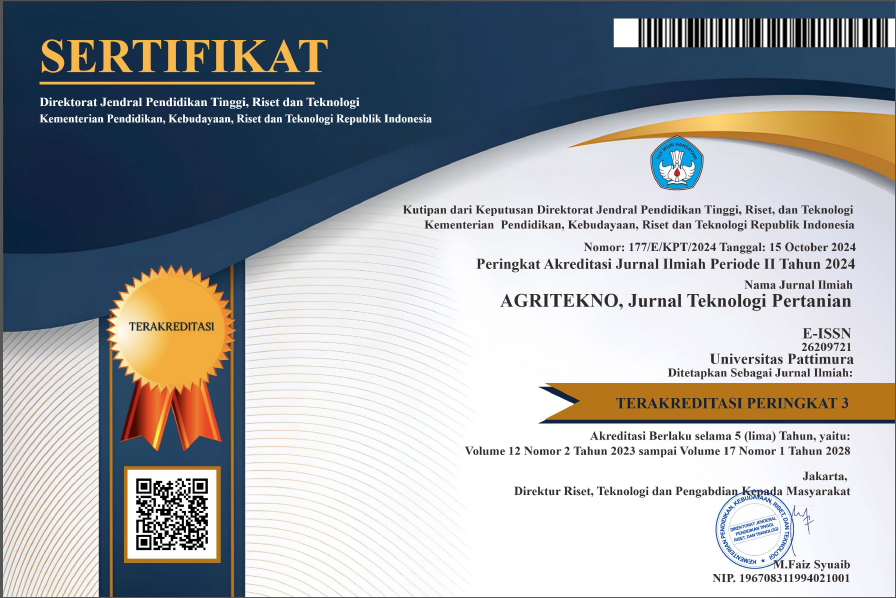Perbandingan Komponen Aktif Minyak Atsiri dari Daging Buah Pala Kering Cabinet Dryer Melalui Metode Distilasi Air dan Air-Uap
Abstract
The demand for essential oils has increased recently due to the growing of parfume, cosmetic, pharacentical, food and beverage, natural flavourings, medicines, aroma therapy, as well as non-food industries. Nutmeg fruit flesh is one of the potential sources of essential oils which can be obtained by both water distilation and water-steam distillation. Gas Chromatography-Mass Spectometry (GC-MS) is a dynamic analytical method to separate and to detect volatile compounds in a mixture. This study was aimed to compare active components of essential oils from cabinet dryer-dried nutmeg fruit flesh by water distillation and water-steam distillation. Results showed that 28 compounds were detected in essential oils of nutmeg flesh by water distillation, while 31 were identified in oil by water-steam distillation. Compounds identified with higher intensity in oil by water distillation were α-pinene (15.8%), β-pinene (12.0%), limonene (7.5%), δ-terpinene (8.7%), terpinene-4 -ol (14.4%), α-terpineol (4.9%), and myristicin (15.6%). The similar compounds were also detected in oil by water-steam distillation but in different quantities such as 13,3%, 8,8%, 7,2%, 8,7%, 15,6%, 7,7%, 13,5%, respectively.
Keywords: distillation method, essential oil component, GC-MS, nutmeg fruit flesh
ABSTRAK
Perkembangan industri parfum, kosmetik, farmasi, makanan dan minuman, penyedap alami, obat-obatan, aroma terapi, maupun industri bukan makanan semakin tahun semakin meningkat yang berakibat meningkatnya kebutuhan minyak atsiri. Daging buah pala menjadi salah satu potensi sumber minyak atsiri yang dapat diperoleh melalui metode distilasi (distilasi air dan distilasi air-uap). Kromatografi Gas Spectrometer Massa (GC-MS) merupakan metode yang dinamis untuk pemisahan dan deteksi senyawa-senyawa yang mudah menguap dalam suatu campuran. Tujuan penelitian ini adalah membandingkan komponen senyawa aktif minyak atsiri dari daging buah pala kering cabinet dryer yang diperoleh dari distilasi air dan distilasi air-uap menggunakan GC-MS. Hasil analisis GC-MS minyak atsiri daging buah pala yang diperoleh melalui distilasi air terdapat 28 senyawa, sedangkan dengan distilasi air-uap diperoleh 31 senyawa. Intensitas tertinggi pada metode distilasi air teridentifikasi sebagai senyawa α-pinene (15,8%), β-pinene (12,0%), limonene (7,5%), δ-terpinene (8,7%), Terpinene-4-ol (14,4%), α-terpineol (4,9%), dan myristicin (15,6%), sedangkan intensitas tertinggi pada metode distilasi air-uap teridentifikasi sebagai senyawa α-pinene (13,3%), β-pinene (8,8%), Limonene (7,2%), δ-terpinene (8,7%), terpinene-4-ol (15,6%), α-terpineol (7,7%), dan myristicin (13,5%).
Kata kunci: daging buah pala, GC-MS, komponen minyak atsiri, metode distilasi
Downloads
References
Asyik, N. dan I. Astuti. 2010. Karakteristik mutu minyak pala (nutmeg oil) Indonesia sebagai bahan baku industri flavor. Agriplus 20: 146-154.
Charles, D.J. and J.E. Simon. 1990. Comparison of extraction methods for the rapid determination of essential oil content and comparison of basil. Journal of the American Society for Horticultural Science 115: 458-462.
Gandjar, G.I. dan A. Rohman. 2007. Kimia Farmasi Analisis. Pustaka Pelajar. Yogyakarta.
Guenther, E. 1987. Minyak Atsiri Jilid I. UI Press. Jakarta.
Halket, J.M., D. Waterman, A.M. Przyborowska, R.K. Patel, P.D. Fraser, and P.M. Bramley. Chemical derivatization and mass spectral libraries in metabolic profilinf by GC/MS and LC/MS/MS. Journal of Experimental Botany 56: 219-243. DOI: 10.1093/jxb/eri069
Harianingsih, R. Wulandari, C. Harliyanto, dan C.N. Andiani. 2017. Identifikasi GC-MS ekstrak minyak atsiri dari sereh wangi (Cymbopogon winterianus) menggunakan pelarut metanol. Techno 18: 23-28.
Khopkar, S.M. 1990. Konsep Dasar Kimia Analitik. UI Press. Jakarta.
Nurhaen, D., Winarsii, dan A. Ridhay. 2016. Isolasi dan identifikasi komponen kimia minyak atsiri dari daun, batang, dan bunga tumbuhan salembangu (Melissa sp.). Natural Science 5: 149-157. DOI: 10.22487/25411969.2016.v5.i2.6702
Sefidkon, F., K. Abbasi, and G.B. Khaniki. 2006. Influence of drying and extraction methods on yield and chemical composition of the essential oil of Satureja hortensis. Food Chemistry 99: 19-23. DOI: 10.1016/j.foodchem.2005.07.026
Sefidkon, F., K. Abbasi, Z. Jamzad, and S. Ahmadi. 2007. The effect of distillation methods and stage of plant growth on the essential oil content and composition of Satureja rechingeri Jamzad. Food Chemistry 100: 1054-1058. DOI: 10.1016/j.foodchem. 2005.11.016
Sipahelut, S.G. 2012. Proporsi persenyawaan teroksigenasi minyak atsiri dari daging buah pala. Ekosains 1: 41-46.
Sulianti, S.B. dan Chairul. 2002. Perbandingan komponen kimia penyusun minyak atsiri sirih liar (Piper ornatum) yang berasal dari Sulawesi Selatan dan pulau Seram dengan sirih biasa (Piper betle). Berita Biologi 6: 493-499.
Syamsul, R. Syahputra, dan Suherman. 2016. Rancang bangun sistem kendali pada proses penyulingan minyak pala untuk optimasi energi. Jurnal Listrik Telekomunikasi Elektronika 13: 55-60.
Copyright (c) 2019 AGRITEKNO, Jurnal Teknologi Pertanian

This work is licensed under a Creative Commons Attribution-ShareAlike 4.0 International License.
Authors who publish with this journal agree to the following terms:
- Authors retain copyright and grant the journal the right of first publication with the work simultaneously licensed under a Creative Commons Attribution License that allows others to share the work with an acknowledgement of the work's authorship and initial publication in this journal.
- Authors are able to enter into separate, additional contractual arrangements for the non-exclusive distribution of the journal's published version of the work (e.g., post it to an institutional repository or publish it in a book), with an acknowledgement of its initial publication in this journal.
- Authors are permitted and encouraged to post their work online (e.g., in institutional repositories or on their website) prior to and during the submission process, as it can lead to productive exchanges, as well as earlier and greater citation of published work (See The Effect of Open Access).








